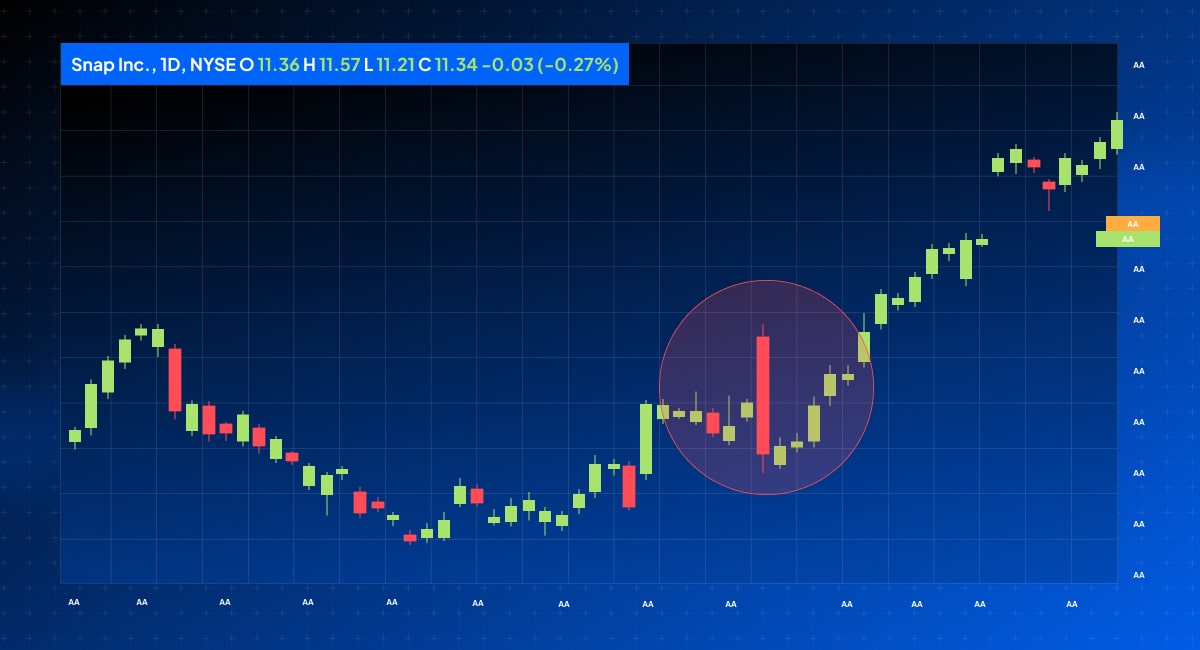Ad growth, cloud, AI: What matters most in Google’s Q1 earnings
Earnings season is among the stock market's most lively and exciting periods. Navigating earnings season requires planning, dedication, and a thorough awareness of the factors that influence market movements.

For traders, it represents a period of increased volatility and unprecedented potential. Companies present quarterly results, which provide insights into their financial performance and prospects. These disclosures can cause individual stocks—and even entire sectors—to rise or fall in moments.
This article will guide you on how to analyse earnings reports, employ advanced trading methods, and use products like CFDs to explore potential opportunities.
Understanding earnings season
Earnings season occurs four times per year, usually beginning a few weeks after the end of a fiscal quarter. During this time, businesses report key performance indicators such as revenue, earnings, and forward projections. Earnings are normally released outside of normal trading hours, but some trading providers offer extended hours to help you capitalise on related volatility.
Why earnings season matters
Earnings season impacts individual companies, entire sectors, and the overall market.
- Sector trends: A strong report from a leading company like Tesla can positively impact the electric vehicle sector.
- Insights: Earnings reports offer macroeconomic data on consumer behaviour, company investment, and global trade trends.
Example
In Q2 2023, strong profits from tech behemoths such as Microsoft and Alphabet fuelled a rally in the NASDAQ, but weaker-than-expected results from consumer staples drove down the S&P 500.

Expectations around earnings season
The key driver of market movement around earnings announcements is not the announcement itself, but how the numbers measure up against expectations. For example, if Meta is widely expected to produce a positive set of data, this optimism will have gradually built into the share price ahead of the announcement. If the announcement is then in line with expectations, it’s unlikely to cause much of a ripple. However, if Meta surprises the markets by releasing numbers that are lower – or higher – than expected, it’s far more likely to spur investors into action.
Ahead of an earnings announcement from a company you’re interested in trading, it’s worth getting familiar with EPS and revenue estimates from analysts and then examining historical patterns. For example, does the stock have a history of beating or missing expectations? By looking at previous quarterly EPS figures against their expectations, you can get a rough estimate of how the market responds and what to expect.
Similarly, if a share price tends to experience major movement after a report, it suggests that market sentiment is significantly influenced by the announcement. But if the share price shows little reaction to the news, perhaps the price is driven more by other factors.
Trading before an announcement
Once you’ve done your research on a particular company, you might:
- Enter a long trade before the announcement, if you believe strong earnings will cause the stock to rise
- Enter a short trade before the announcement, if you believe disappointing earnings will cause the stock to decline
Capitalising on post-earnings momentum
Once earnings are announced, you can capitalise on the market’s initial reaction:
- Positive reaction: A strong earnings beat can lead to multi-day rallies.
- Negative reaction: Earnings misses, or weak guidance can trigger significant selloffs.
Example:
In Q1 2022, Meta Platforms reported a sharp decline in ad revenue, which led to a 25% drop in its stock price. Traders who shorted Meta just after the announcement made a profit, as investors got spooked and sold off some of their Meta portfolio over the coming hours and days.

How to analyse a company’s earnings report
An earnings report contains a wealth of data. To make informed trades, you could focus on the following:
Core metrics
The top-line numbers highlighting overall performance:
- Revenue growth: Is the company growing sales year-over-year (YoY)?
- Earnings per share (EPS): Does the company beat or miss EPS expectations?
Margins
Providing insight into operational efficiency:
- Gross margin: Indicates cost control.
- Net margin: Reflects overall profitability.
Forward guidance
A company’s prediction of future earnings, often carrying more weight than actual results:
- Positive guidance signals confidence in future growth.
- Weak guidance can lead to significant selloffs, even if the company beats EPS estimates.
Free cash flow (FCF)
Free cash flow reflects a company’s ability to generate cash after expenses. Positive FCF indicates financial flexibility.
Debt metrics
- Debt-to-equity ratio: High debt levels can signal risk in a rising interest rate environment.
- Interest coverage ratio: This shows how easily a company can service its debt.
Example:
In Q4 2022, Tesla’s earnings revealed strong free cash flow growth, reassuring investors despite challenges in delivery numbers. The stock rallied 15% after the announcement.

Seasonal trends and sector-specific patterns
Research your sector carefully to understand if there are broader factors likely to affect performance, and whether this may already be built into the price.
- Retail: Q4 earnings often reflect holiday sales strength.
- Energy: Q1 earnings align with winter demand peaks.
How to trade on an earnings announcement
There are various ways to capitalise on price movements around earnings announcements.
Investing in the stock
If your research suggests a positive mid- to long-term outlook for the company, you may want to invest in its stock. This means you’ll own a portion of the company and can make capital gains if you later sell your shares for a higher price than you bought them for. There’s also the potential to receive dividend payments if the companies issues them, and also to receive voting rights in important company matters.
Options
These can offer a flexible way to trade if you’re expecting a market to move, but you’re not sure in which direction. For example, straddles and strangles provide the potential to profit from significant price movements in either direction, while iron condors essentially do the opposite, enabling you to benefit from reduced volatility after earnings. However, it's important to note that while these strategies can lead to profits, they also carry the risk of losses.
CFDs
Contracts for difference (CFDs) can be a great way to trading earnings announcements, because they allow you to speculate on price movements without owning the underlying asset. This means you can go long just as easily as short, profiting from movements in either direction. As well as company shares, you can trade whole indices, commodities, forex and more from a single account.
CFDs are a leveraged product, meaning you only have to put down a small portion of your overall exposure in order to trade. This can amplify your profits, but also your losses.
Trading CFDs with Pepperstone
Pepperstone offers round-the-clock trading and fast execution, enabling you to trade the moment markets move. Our suite of advanced trading tools and integrations means you’ll never need to miss an opportunity.
- Round-the-clock trading on key US stocks: get ahead of market movements by trading before, during and after an announcement.
- Razor-sharp spreads: starting from 0.0 points on a Razor CFD account, with low commission and no hidden fees
- 1350+ instruments: think an earnings announcement might affect a whole index? Trade global shares, indices, ETFs and more
- Local, personalised support: our award-winning client service team is here to assist you 24/5
- Smart tech integrations: plug into MT4, MT5, cTrader, Trading View and more to gain access to the world’s most cutting-edge trading tools.
It normally takes just a few minutes to set up your account, and you can fund it from as little as $10.
Managing your risk during earnings season
Earnings season’s unpredictability requires disciplined risk management. Consider the following before placing a trade – and to help monitor your positions.
Set stop-losses and take-profits
Set stop-loss levels to limit your potential downside during volatile moves. Some brokers, like Pepperstone, even offer trailing stops, which lock in positive market moves while capping your risk.
Take-profits can realise your profit once it reaches a certain level, closing your position before the market reverses and gains are lost.
Be mindful of position sizing
Keep individual trades within a manageable percentage of your overall portfolio. Some traders employ the 2% rule, which means never risking more than 2% of your trading capital on a single position.
Place price alerts
To avoid having to watch the market like a hawk, brokers like Pepperstone enable you to be notified if the price hits a specified level. You can then decide how best to act.
Common pitfalls to avoid
- Over-leveraging: Avoid using excessive leverage during high volatility.
- Ignoring guidance: Forward guidance often outweighs actual results.
- Emotional trading: Stick to your strategy and avoid impulsive decisions.
How market reactions vary based on previous quarters
Stocks with consistent beats often see more minor price reactions, while underperformers can experience exaggerated moves on surprises.

Conclusion
Earnings season is a time of high opportunity for disciplined traders. By analysing key metrics, thinking strategically, and using flexible trading products such as CFDs, you can capitalise on this period of heightened market activity. Success lies in preparation, adaptability, and risk management. As always, if you need further clarification or assistance, speak to your Pepperstone contact first.
PS: It’s possible that you may be stopped out at a worse level than requested if the market moves quickly or gaps.
''The information contained within this article is strictly for educational purposes. If you wish to apply these technical trading strategies, you need to know of the risks involved and that past success does not guarantee future results.''
Ready to trade?
It's quick and easy to get started. Apply in minutes with our simple application process.
The material provided here has not been prepared in accordance with legal requirements designed to promote the independence of investment research and as such is considered to be a marketing communication. Whilst it is not subject to any prohibition on dealing ahead of the dissemination of investment research we will not seek to take any advantage before providing it to our clients.
Pepperstone doesn’t represent that the material provided here is accurate, current or complete, and therefore shouldn’t be relied upon as such. The information, whether from a third party or not, isn’t to be considered as a recommendation; or an offer to buy or sell; or the solicitation of an offer to buy or sell any security, financial product or instrument; or to participate in any particular trading strategy. It does not take into account readers’ financial situation or investment objectives. We advise any readers of this content to seek their own advice. Without the approval of Pepperstone, reproduction or redistribution of this information isn’t permitted.